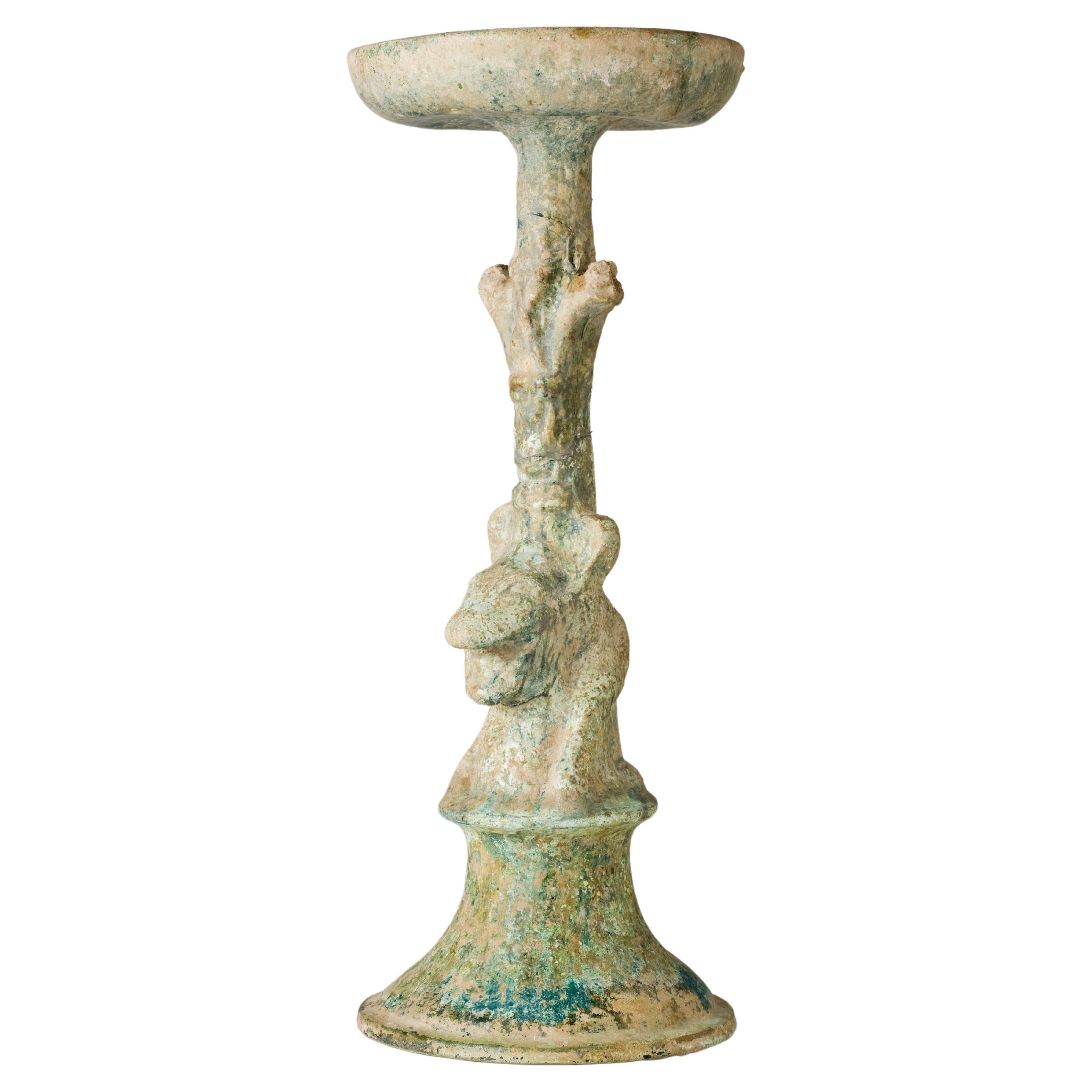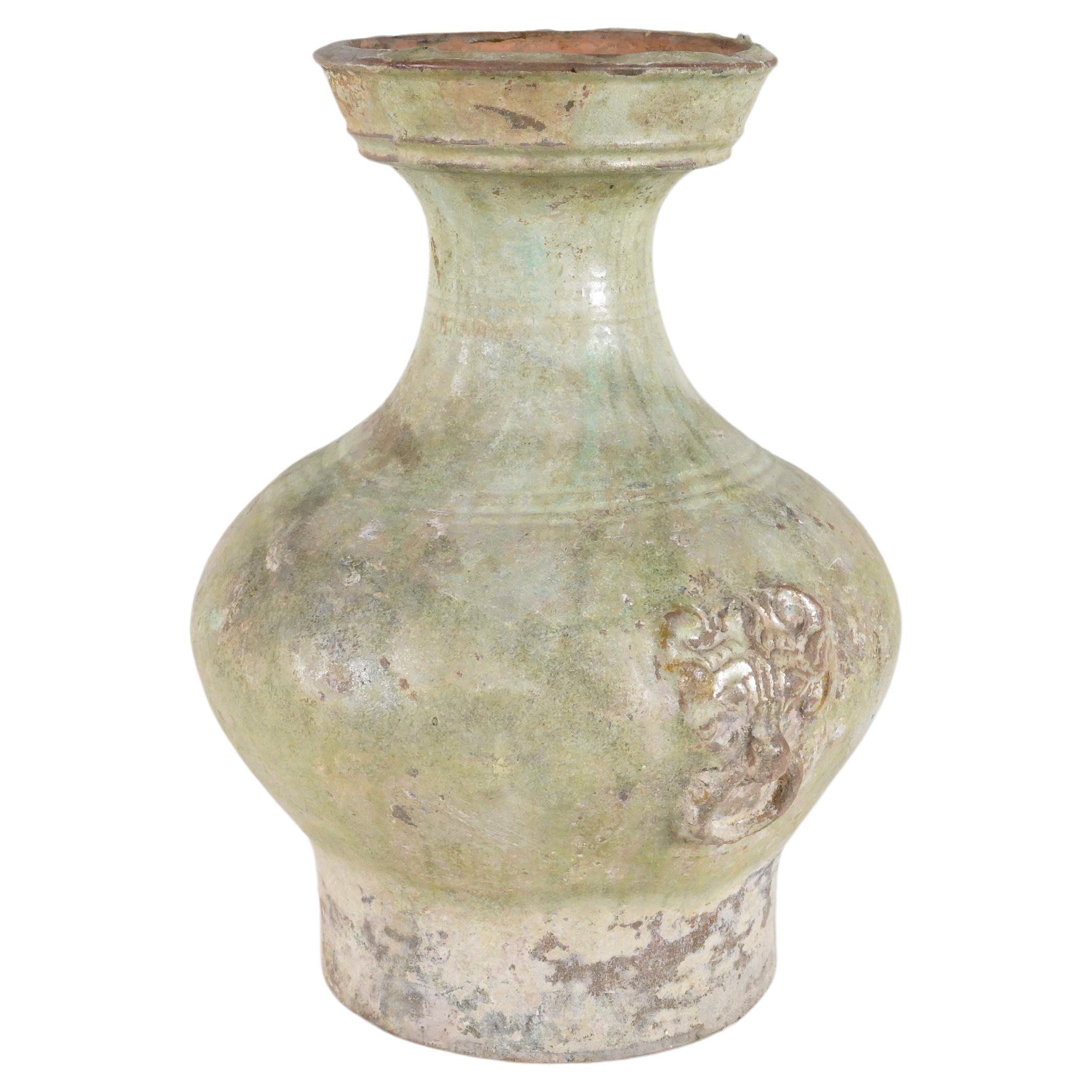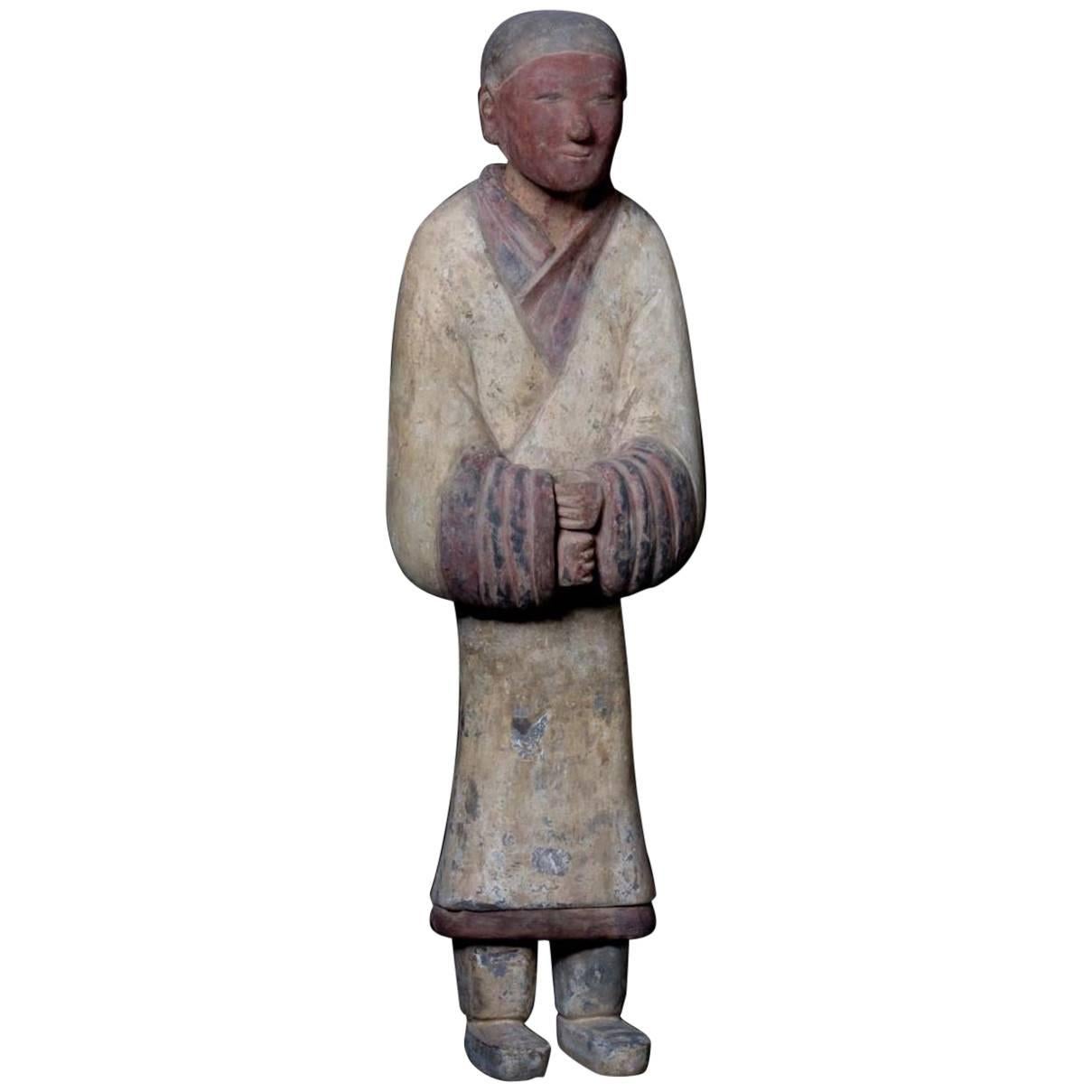Items Similar to Green-glazed pottery tripod 'hill' jar, Han Dynasty, 206 BC - 220 AD
Want more images or videos?
Request additional images or videos from the seller
1 of 21
Green-glazed pottery tripod 'hill' jar, Han Dynasty, 206 BC - 220 AD
About the Item
The modelled animal figures and landscapes of this piece represent the Daoist ideology of the Han dynasty. The mountain-shaped lid refers to the sacred dwellings of the immortals, the Kunlun mountains, which was ruled by the Queen Mother of the West. The sides decorated with stylized fantastic animals. A pottery covered jar, zun, of cylindrical form, supported on three moulded feet in the form of bears that rest their hands on their knees. The straight sides are evenly divided into two parts by two ridges. "Iridescence" is observed in surface.
Period : Han Dynasty (206 BC - 220 AD)
Type : Green-Glazed
Medium : Earthenware
Provenance : Acquired in 1999, Hongkong
Reference : British Museum incence burner (Museum number 1909,0512.29)
* Han Dynasty Green-Glaze
Han Dynasty Green Glaze Pottery represents a significant aspect of ancient Chinese ceramics. Spanning from 206 BCE to 220 CE, this period marked a considerable advancement in pottery techniques and aesthetic refinement compared to earlier times.
The pottery is renowned for its distinctive green glaze, achieved through the use of copper-containing glazes. These glazes produced the green color during firing, as compounds with copper oxide reacted. This green glaze imparted a unique artistic effect, reflecting significant artistic values in Chinese society of the time.
Han Dynasty pottery also showcased advancements in form and design, reflecting the complexity and sophistication of the society and culture. These pieces, varying in shapes and sizes, often featured intricate decorations. Many were used as burial objects, reflecting ancient Chinese beliefs about death and the afterlife.
Reference : Ben Jassens Oriental Art
- Dimensions:Height: 10.08 in (25.6 cm)Diameter: 7.88 in (20 cm)
- Style:Han (Of the Period)
- Materials and Techniques:
- Place of Origin:
- Period:
- Date of Manufacture:206BC-220AD
- Condition:Minor fading.
- Seller Location:seoul, KR
- Reference Number:1stDibs: LU9577237638962
About the Seller
New to 1stDibs
Joined in the past six months.
4.5
Vetted Seller
These experienced sellers undergo a comprehensive evaluation by our team of in-house experts.
Established in 1999
1stDibs seller since 2023
Typical response time: 1 hour
- ShippingRetrieving quote...Ships From: seoul, Korea South
- Return PolicyA return for this item may be initiated within 10 days of delivery.
More From This SellerView All
- Green-glazed pottery lampstand, Han Dynasty(206BC-220AD)Located in seoul, KRThe upper section of the vessel is broad and flat, intended to support a candle or an oil lamp, while the stem and base are robust, designed for stability and durability. The surface...Category
Antique 15th Century and Earlier Chinese Han Antiquities
MaterialsEarthenware
- Hu Shape Green-Glazed Vase, Han Dynasty(206 BC - 220 AD)Located in seoul, KRA 'Hu' is a type of large jar or pot that was commonly used in China for storage purposes, including holding liquids or dry goods like grains. This particular shape of pottery usually features a wide body and a narrow opening, and sometimes comes with a lid. The 'Hu' could also be more elongated with a slender neck, designed for easy pouring of liquids. The rainbow-like colors on this green-glazed surface come from changes that happen over hundreds of years while it's buried. This process is also known as "iridescence" and is often observed in ancient Chinese green pottery...Category
Antique 15th Century and Earlier Chinese Han Antiquities
MaterialsEarthenware
- Green-Glazed Tripod Vessel, Han DynastyLocated in seoul, KRHan Dynasty green-glazed tripods are comparatively rare, especially ones that have retained their structural integrity and glaze over millennia. Pieces in good condition are scarce b...Category
Antique 15th Century and Earlier Chinese Han Antiquities
MaterialsEarthenware
- Green-glazed pottery 'figural' lamp, Han DynastyLocated in seoul, KRThe lamp shaped as a kneeling female figure wearing long robes, her face with a large nose, deep-set eyes and pronounced cheeks, holding an infant in her lap, her cylindrical and elo...Category
Antique 15th Century and Earlier Chinese Han Antiquities
MaterialsEarthenware
- Sancai-Glazed Pottery Tripod Jar, Tang DynastyLocated in seoul, KRThe globular body is supported on three claw feet and is covered in a splashed-glaze of amber, green and cream color, which stops short of the unglazed base. Date : Tang Dynasty(61...Category
Antique 15th Century and Earlier Chinese Tang Antiquities
MaterialsEarthenware
- Milling Shed pottery with Green Glaze, Eastern Han DynastyLocated in seoul, KRMade from the standard orange earthenware body of Han green glazed tomb models, this miniature milling station features a circular millstone and a foot...Category
Antique 15th Century and Earlier Chinese Han Antiquities
MaterialsEarthenware, Pottery
You May Also Like
- A Large Han Dynasty (206BC-220AD) Glazed Hu VesselLocated in Chicago, ILThis is a fine example of a Han hu wine storage vessel, buried for the afterlife. The compressed globular body narrows sharply to a slender waisted neck, covered with a dark green le...Category
Antique 15th Century and Earlier Chinese Han Antiquities
MaterialsTerracotta
- A Han (206BC -220AD) Glazed Hu VesselLocated in Chicago, ILThis is a fine, heavily patinated example of a Han hu wine storage vessel, buried for the afterlife. The compressed globular body narrows to a slender waisted neck, covered with a da...Category
Antique 15th Century and Earlier Chinese Han Antiquities
MaterialsTerracotta
- Elegant Han Dynasty Terracotta Warrior - China '206 BC - 220 AD'Located in San Pedro Garza Garcia, Nuevo LeonImpressive terracotta warrior representing a banner bearer gripping a wooden staff with his hands (dematerialized through the ages); his gaze is ser...Category
Antique 15th Century and Earlier Chinese Han Antiquities
MaterialsTerracotta
- Ancient China Monumental Stone Ram Han Dynasty, 206BC-220ADLocated in South Burlington, VTChina, a large votive model of a stone ram, Han dynasty (206BC-220AD) Dimensions: 45cm, 18 inches high and 65cm, 26 inches length and 25cm, 10 inches wi...Category
Antique 15th Century and Earlier Chinese Han Sculptures and Carvings
MaterialsLimestone
- Monumental Han Dynasty Terracotta Horse - TL Tested - China, '206 BC–220 AD'Located in San Pedro Garza Garcia, Nuevo LeonA massive pottery horse with separately made head and tail, standing on all fours and striding with its right hoof forward. Extended snout ends in parted lips showing teeth beneath i...Category
Antique 15th Century and Earlier Chinese Han Antiquities
MaterialsTerracotta
- Eastern Han Dynasty Terracotta Model of a Paper Mill , China '206BC - 220AD'Located in San Pedro Garza Garcia, Nuevo LeonSlab pottery constructed Model of a Paper Mill, in Green and Cream Color Glazed Terracotta having a peaked roof – open walled form with a mechanical pounder and a large round storage container. Light blue-green mottled glazed surface with some iridescence patina to the glaze. The Iridescence is a refraction of the layers on the glass that produces multicolor hues & metallic luster, and only develops after one thousand years of being buried in the ground. An unquestionable mark of antiquity, impossible to falsify. Han Dynasty, dated 206 B.C-220 A.D. Condition: Excellent, wear commensurate with age, an unusual example. This fantastic piece is accompanied by a Certificate of Authenticity. Sculptural effigies of domesticated animals were often interred in the tombs of nobility and elite members of the social hierarchy. Models like this one were made to represent everything from simple goat or pig pens to the most elaborate towers and palaces. Because very few ancient Chinese buildings have survived intact, these models, along with descriptions from ancient texts, give a good representation of what the buildings might have looked like. Burial figurines of graceful dancers, mystical beasts, and everyday objects reveal both how people in early China approached death and how they lived. Since people viewed the afterlife as an extension of worldly life, these figurines, called mingqi, sometimes referred as “spirit utensils” or “vessels of ghosts” disclose details of routine existence and provide insights into belief systems over a thousand-year period. For the first time in Chinese history, we have images of rural and daily life during the Han in the form of contemporary records...Category
Antique 15th Century and Earlier Chinese Han Antiquities
MaterialsTerracotta
Recently Viewed
View AllMore Ways To Browse
Han Dynasty Tripod
Wooden Happy Buddha
80s Statue
Taiwan Coral
Han Dynasty Tripod
In Italian
With Three Pieces
Leather Seater
Midcentury And Modern Chandeliers
Nature Objects
French 20th Lighting
Initials Century
X Dining Chair
Pull Top
Square Pattern
Ceramic Vase 20th Century
Unique Chandelier Light
Antique Print Of A Plate




